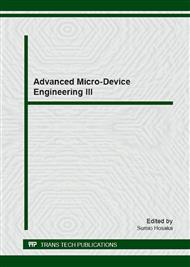p.7
p.12
p.17
p.22
p.26
p.31
p.36
p.40
p.46
Synthesis of MnZn-Ferrite Using Sintering Aids
Abstract:
Mn0.7Zn0.3Fe2O4 is synthesized by sintering the nanosize precursor with sintering aids, which is synthesized by the coprecipitation method. The crystal growth of Mn0.7Zn0.3Fe2O4 is controlled by the amount of sintering aids. Complex permeability is explained by the Maxwell-Garnett (MG) effective medium model. The ferromagnetic resonance frequency more than 1 GHz can be explained by the shape anisotropy under the sintering process of the Mn0.7Zn0.3Fe2O4 particles. These results suggest possibility of Mn0.7Zn0.3Fe2O4 as a high frequency device material.
Info:
Periodical:
Pages:
26-30
Citation:
Online since:
January 2013
Price:
Сopyright:
© 2013 Trans Tech Publications Ltd. All Rights Reserved
Share:
Citation:


